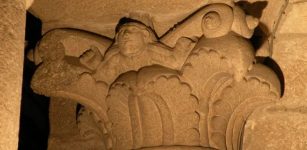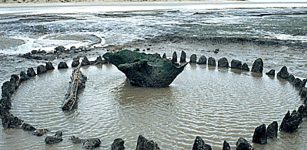Keshwa Chaca – Last Suspension Rope Bridge Of Inca People
A. Sutherland - AncientPages.com - Hanging rope bridges (or the so-called suspension rope bridges) were built by the Inca over canyons, rivers, and ravines. They linked the Inca Empire, providing access to even the most inaccessible region.
Inca suspension rope bridge - Credit: Adobe Stock - Danita Delimont
Five centuries ago, the Andes were filled with hanging bridges. It is believed there were as many as two hundred of them. Also, in Peru – due to the country’s difficult geography, many places were joined by suspension bridges made of vegetable fiber.
The so-called “suspension rope bridges” or “hanging bridges” were important to the Inca’s road infrastructure. They were needed for trade, communication, development, and dominance over the region.
Today, only one suspension rope bridge is left, known as “Keshwa Chaca” (or Q´eswachaka). The Inca have an old tradition of renovating this bridge. Each year, several Cusco families (about a thousand people from different communities ) meet at the bridge's location and prepare a new structure during four days of hard work.
The bridge is located in the department of Cusco, over the Apurímac River, at 3,700 m above sea level.
The “Keshwa Chaca” bridge has been there for 500 years, and the tradition of renewing it has been continued from generation to generation. This bridge owes its existence to the involvement of the local population, which rebuilt it in June each year according to techniques that the Inca ancestors used.
What Keshwa-Chaca Is Made Of?
The Inca suspension rope bridge is created of four parallel ropes (each of them consists of three intertwined cords), on which small twigs are arranged diagonally. Two additionally suspended ropes (they are much thinner) form a handrail. They are connected to the bridge by a system of vertical ropes arranged close to each other, forming balustrade-like support for safety while traversing the bridge.
The whole structure is fastened to stone platforms (abutments) on both sides of the ravine.
Reconstruction Of Keshwa Chaca Takes Three Days
On the first day, people of the communities go out and search for a solid straw of vegetal fiber (in Quechua, it is called “Ichu”). Such fibers were and are today used for the construction of the last hanging rope bridge.
Keshwa Chaca - Suspension Rope Bridge. Credit: Adobe Stock - Danita Delimont
Once the required amount of Ichu has been collected, women weave the straw to form strong ropes, and when they are ready, men begin their job because they are responsible for joining the rope from end to end and then braiding it.
During the second day, the structure of the old bridge is disarmed and removed along with the stone nails that sustain the bridge. Then, the four new ropes that are the base of the structure of the new bridge are placed.
On the third day, the villagers work with assembling the handrails and the bridge's surface. The fourth day is the time of celebration of the reconstruction of the bridge. According to the ancient 500 hundred years old custom, the Inca people listen to their traditional music and perform indigenous dances.
Over time, many bridges were damaged or totally destroyed due to weather conditions (they are constructed at very high altitudes - Keshwa Chaca is 3,700 m above sea level), and the strength of the used material is also low.
However, despite the apparently low strength of the materials used in their construction, the Inca’s Keshwa Chaca is able to maintain the weight of 56 people.
Updated on October 14, 2023
Written by – A. Sutherland - AncientPages.com Senior Staff Writer
Copyright © AncientPages.com All rights reserved. This material may not be published, broadcast, rewritten or redistributed in whole or part without the express written permission of AncientPages.com
Expand for referencesMore From Ancient Pages
-
 What America’s First Board Game Can Teach Us About The Aspirations Of A Young Nation
Featured Stories | Jun 6, 2024
What America’s First Board Game Can Teach Us About The Aspirations Of A Young Nation
Featured Stories | Jun 6, 2024 -
 Hidden Carving Of Stonemason Never Meant To Be Seen Discovered In Cathedral Santiago De Compostela
News | Nov 2, 2020
Hidden Carving Of Stonemason Never Meant To Be Seen Discovered In Cathedral Santiago De Compostela
News | Nov 2, 2020 -
 Remarkable 4,000-Year-Old Seahenge In Norfolk – What Was The Purpose Of The Bronze Age Monument?
Featured Stories | Jul 4, 2022
Remarkable 4,000-Year-Old Seahenge In Norfolk – What Was The Purpose Of The Bronze Age Monument?
Featured Stories | Jul 4, 2022 -
 Table Manners And First Code Of Correct Behavior Were Introduced In Egypt 2,500 B.C. By Ptahhotep
Ancient History Facts | Oct 26, 2020
Table Manners And First Code Of Correct Behavior Were Introduced In Egypt 2,500 B.C. By Ptahhotep
Ancient History Facts | Oct 26, 2020 -
 On This Day In History: Bolsheviks Executed Aleksandr Kolchak, A Navy Officer And Explorer Of The Arctic – On Feb 7, 1920
News | Feb 7, 2017
On This Day In History: Bolsheviks Executed Aleksandr Kolchak, A Navy Officer And Explorer Of The Arctic – On Feb 7, 1920
News | Feb 7, 2017 -
 Is The Legendary Tsuchinoko Real?
Featured Stories | Aug 21, 2019
Is The Legendary Tsuchinoko Real?
Featured Stories | Aug 21, 2019 -
 On This Day In History: Declaration Of Arbroath – The Scots Reaffirm Their Independence – On Apr 6, 1320
News | Apr 6, 2016
On This Day In History: Declaration Of Arbroath – The Scots Reaffirm Their Independence – On Apr 6, 1320
News | Apr 6, 2016 -
 Yasuke – The First Black Samurai Caused A Sensation In Japan
Featured Stories | Oct 25, 2019
Yasuke – The First Black Samurai Caused A Sensation In Japan
Featured Stories | Oct 25, 2019 -
 World’s Oldest Hand And Footprints Discovered On The Tibetan Plateau Are 226,000-Year-Old!
Archaeology | Sep 15, 2021
World’s Oldest Hand And Footprints Discovered On The Tibetan Plateau Are 226,000-Year-Old!
Archaeology | Sep 15, 2021 -
 How Many Ice Ages Has The Earth Had, And Could Humans Live Through One?
Featured Stories | Sep 26, 2022
How Many Ice Ages Has The Earth Had, And Could Humans Live Through One?
Featured Stories | Sep 26, 2022 -
 New DNA Study Of The Red Lady Of El Mirón Who Lived 19,000 Years Ago
DNA | Feb 7, 2025
New DNA Study Of The Red Lady Of El Mirón Who Lived 19,000 Years Ago
DNA | Feb 7, 2025 -
 Amazing Photos Of Ancient Ruins Hidden Under Thessaloniki Metro Revealed By Archaeologists
Archaeology | Jan 9, 2023
Amazing Photos Of Ancient Ruins Hidden Under Thessaloniki Metro Revealed By Archaeologists
Archaeology | Jan 9, 2023 -
 Mysterious Ichthys – Ancient Secret Christian Symbol With A Deep Meaning
Ancient Symbols | Mar 6, 2018
Mysterious Ichthys – Ancient Secret Christian Symbol With A Deep Meaning
Ancient Symbols | Mar 6, 2018 -
 Descent Of Orpheus To Underworld Ruled By Hades
Featured Stories | Jan 14, 2018
Descent Of Orpheus To Underworld Ruled By Hades
Featured Stories | Jan 14, 2018 -
 Our New Relative: ‘Homo Luzonensis’ – New Species Of Early Human Found
Archaeology | Apr 11, 2019
Our New Relative: ‘Homo Luzonensis’ – New Species Of Early Human Found
Archaeology | Apr 11, 2019 -
 God’s Personal Flying Vehicle Described In ‘The Book of Ezekiel’
Biblical Mysteries | Jul 18, 2019
God’s Personal Flying Vehicle Described In ‘The Book of Ezekiel’
Biblical Mysteries | Jul 18, 2019 -
 Temple Dedicated To Goddess Nemesis Discovered Under Ancient Theater In Greece
Archaeology | May 20, 2019
Temple Dedicated To Goddess Nemesis Discovered Under Ancient Theater In Greece
Archaeology | May 20, 2019 -
 Controversial Ruler Tsar Boris Godunov’s Exact Date Of Birth Determined By Scientists
Archaeology | Aug 31, 2021
Controversial Ruler Tsar Boris Godunov’s Exact Date Of Birth Determined By Scientists
Archaeology | Aug 31, 2021 -
 Slaves In The Aztec Empire Had Much Better Rights Than In Any Other Ancient Society
Ancient History Facts | Jul 6, 2016
Slaves In The Aztec Empire Had Much Better Rights Than In Any Other Ancient Society
Ancient History Facts | Jul 6, 2016 -
 Lost Biblical City, Ancient Treasure And Atlantis – Biblical And Archaeological Perspective
Ancient Mysteries | Apr 27, 2018
Lost Biblical City, Ancient Treasure And Atlantis – Biblical And Archaeological Perspective
Ancient Mysteries | Apr 27, 2018


